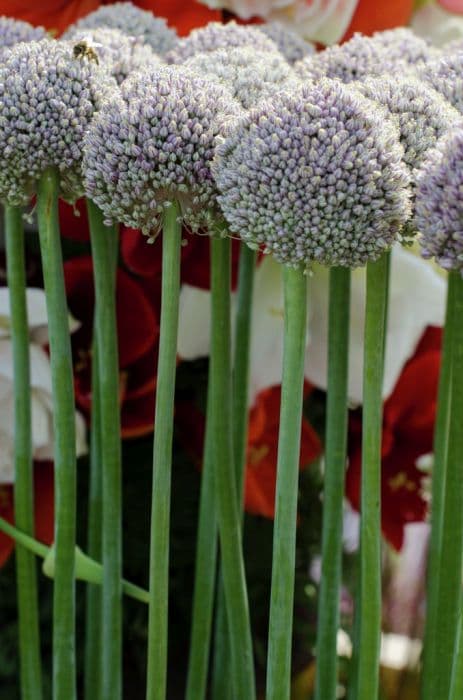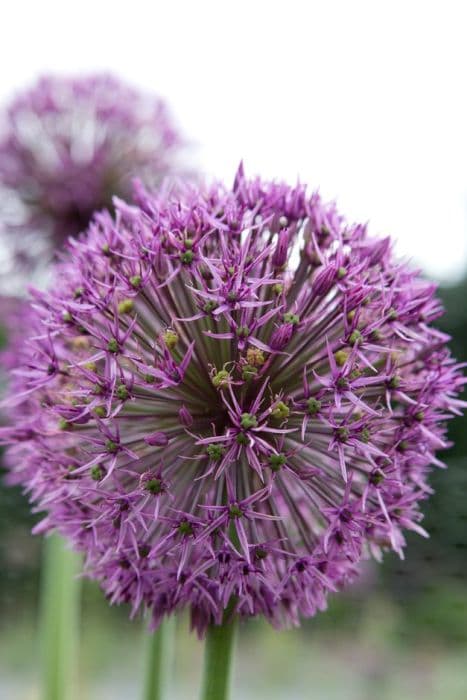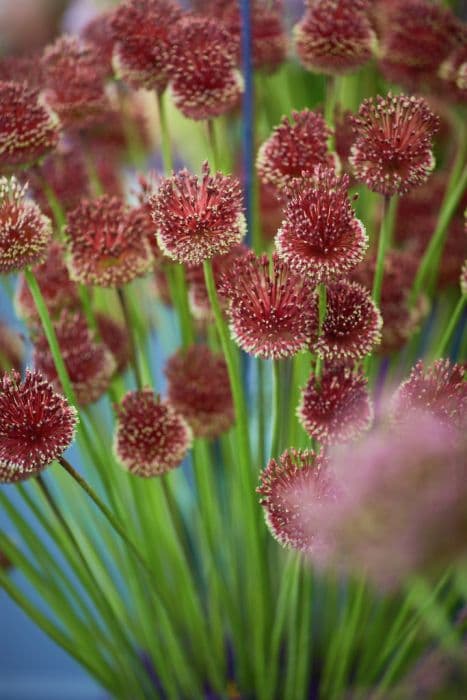There is no widely recognized common name for Allium tripedale; it is typically referred to by its scientific name. Allium tripedale

ABOUT
Allium tripedale, often known simply as wild onion, is known for its distinctive appearance characterized by a clump of green, long, slender leaves. The leaves are typically glossy and can be somewhat fleshy. The plant bears star-shaped flowers, which are usually borne on stalks that rise above the foliage. These flowers are quite showy and can be of various colors, commonly in shades of purple, but they may also be white or pink. The flower heads are usually spherical or hemispherical and made up of numerous small florets. The bulbs of the wild onion plant are also a notable feature; they are generally rounded, nestled in the soil from which the leaves emerge. The plant's overall visual impression is of a delicate yet striking herbaceous plant that brings both color and a unique form to any setting in which it grows. Wild onions are often appreciated for their ornamental flowers as well as their culinary uses, where the onion-like flavor of their bulbs and foliage can be utilized.
About this plant
 Names
NamesFamily
Amaryllidaceae
Synonyms
Tripedal Onion, Three-footed Leek, Three-footed Garlic
Common names
Allium tripedale.
 Toxicity
ToxicityTo humans
There is limited specific information available on the toxicity of Allium tripedale, commonly known as wild onion or wild garlic, to humans. Generally, species in the Allium family are known to contain compounds that can be harmful in large quantities, such as thiosulphates. However, in most cases, these plants are only toxic to humans if consumed in extremely large amounts. Eating reasonable amounts of wild onion or wild garlic is not known to be harmful to humans, and these plants are even used in cooking for their flavor. If an unusually large quantity were consumed, potential symptoms could include gastrointestinal upset, such as nausea, vomiting, and diarrhea.
To pets
Allium tripedale, commonly known as wild onion or wild garlic, is toxic to pets, including cats and dogs. Members of the Allium family contain compounds that can cause oxidative damage to red blood cells, potentially leading to hemolytic anemia. The symptoms of poisoning in pets can include vomiting, diarrhea, abdominal pain, loss of appetite, weakness, and lethargy. In severe cases, hemolytic anemia can result in discolored urine, rapid breathing, elevated heart rate, and collapse. If you suspect your pet has ingested wild onion or wild garlic, it is crucial to seek veterinary attention promptly.
 Characteristics
CharacteristicsLife cycle
Perennials
Foliage type
Deciduous
Color of leaves
Green
Flower color
Purple
Height
2 feet (0.61 meters)
Spread
1 foot (0.30 meters)
Plant type
Bulb
Hardiness zones
8
Native area
Iran
Benefits
 General Benefits
General Benefits- Culinary Uses: Allium tripedale, commonly known as wild leek, can be used in cooking for its flavor, which is reminiscent of onions and garlic.
- Aesthetic Appeal: The plant adds beauty to gardens with its delicate flowers and can be used in ornamental flower beds.
- Pollinator Attraction: Wild leek flowers can attract bees and other pollinators, which are essential for the health of many ecosystems and the pollination of crops.
- Erosion Control: The root system of wild leek can help stabilize soil and prevent erosion in certain environments.
- Cultural Significance: Wild leek has cultural importance in certain regions and is celebrated in events and festivals, which helps to maintain traditions.
- Edible Landscaping: This plant can be incorporated into edible landscaping, providing both a food source and ornamental value.
- Wildlife Habitat: It provides a natural habitat for certain wildlife species, particularly those that rely on native flora.
- Low-Maintenance: Once established, wild leek often requires little care and can thrive in various conditions, making it suitable for many gardeners.
 Medical Properties
Medical PropertiesThis plant is not used for medical purposes.
 Air-purifying Qualities
Air-purifying QualitiesThis plant is not specifically known for air purifying qualities.
 Other Uses
Other Uses- Allium tripedale, commonly known as tripedale onion, can serve as a natural pest deterrent in gardens due to its pungent aroma, which is unappealing to many insects and browsing animals.
- The strong scent of tripedale onion can be used in companion planting to mask the fragrance of more susceptible plants, thereby providing a protective barrier against pests.
- Dried tripedale onion flowers can create unique and lasting arrangements for ornamental purposes, adding aesthetic value well beyond their blooming season.
- The plant's sturdy stems allow it to be used in structural garden designs, providing height and texture contrast in a floral setting.
- When crushed, the leaves of tripedale onion can be rubbed on the skin as a traditional insect repellent in rural areas.
- The tripedale onion can act as a soil indicator plant, where its presence suggests well-drained soil with higher sulfur content, guiding gardeners in crop planning.
- Trimmed foliage from the tripedale onion can be added to compost piles as a source of green matter, contributing to nutrient cycling in garden ecosystems.
- By planting tripedale onion, one can attract pollinators like bees and butterflies to the garden, enhancing pollination for various crops and flowering plants.
- The flower heads of the tripedale onion can be used in natural dye production, imparting colors varying from green to yellow, depending on the mordant used.
- The seeds of tripedale onion can be offered to seed exchange programs, fostering biodiversity and preserving the genetics of heirloom plant species.
Interesting Facts
 Feng Shui
Feng ShuiThe Allium tripedale is not used in Feng Shui practice.
 Zodiac Sign Compitability
Zodiac Sign CompitabilityThe Allium tripedale is not used in astrology practice.
 Plant Symbolism
Plant Symbolism- Resilience: The Allium tripedale, commonly known as "wild onion," is a hardy plant that can grow in challenging environments, symbolizing the ability to endure and thrive in difficult circumstances.
- Unity: The clustered nature of the wild onion's blooms resembles unity and togetherness, representing the idea that strength is found in numbers.
- Humility: Despite its strong flavor and aroma, the wild onion grows close to the ground, symbolizing humility and modesty in character.
- Protection: Historically, wild onions have been believed to provide protection against evil spirits and illness, representing safety and security.
- Healing: Due to its medicinal properties, the wild onion can symbolize healing and the restorative power of nature.
 Water
WaterThe onion relative known as Allium tripedale requires moderate watering, following the general rule for most alliums. It is best to water the plant thoroughly, allowing the soil to become moist but not waterlogged. Typically, watering once a week with about 1 gallon of water should suffice, depending on the weather conditions and soil drainage. During periods of drought or extreme heat, increase the frequency to twice a week. Reduce the amount of water during the dormant season when the plant is not actively growing.
 Light
LightAllium tripedale, commonly referred to as Tripedale Onion, prefers full sun to partial shade conditions. For optimal growth, plant it in a location that receives at least six hours of direct sunlight per day. If you live in a particularly hot climate, providing some afternoon shade will help protect the plant from scorching.
 Temperature
TemperatureThe Tripedale Onion tolerates a range of temperatures and can withstand a minimum temperature down to about 20°F. The ideal temperature range for this plant's growth is between 50°F and 75°F. While it can survive short periods of extreme cold or heat, prolonged exposure to temperatures outside this range can be detrimental to the plant.
 Pruning
PruningFor Tripedale Onion, pruning is mainly done to remove spent flower stalks and to tidy up the plant's appearance, encouraging a neat growth habit. Prune the plant after flowering, cutting back the flower stalks close to the base to prevent self-seeding unless seed propagation is desired. Generally, once a year pruning is sufficient, and it is best done during late summer or fall, after the plant has finished blooming.
 Cleaning
CleaningAs needed
 Soil
SoilTo cultivate Allium tripedale, commonly known as Three-legged Leek, use a well-draining soil mix with a pH of around 6.0 to 7.0. A recommended soil mixture is one part garden soil, one part compost, and one part coarse sand or perlite to ensure proper drainage and fertility.
 Repotting
RepottingThree-legged Leek typically does not require frequent repotting and can be done every 2 to 3 years. Repotting should be carried out in the spring or autumn when the plant is not in active growth.
 Humidity & Misting
Humidity & MistingThree-legged Leek, like most alliums, is tolerant of a wide range of humidity levels and does not have specific humidity requirements. Typical outdoor humidity conditions are usually sufficient.
 Suitable locations
Suitable locationsIndoor
For indoor growth, ensure sunny spot and well-draining soil for Three-legged Leek.
Outdoor
Plant in full sun, rich soil, and space bulbs 15 cm apart for Three-legged Leek.
Hardiness zone
4-9 USDA
 Life cycle
Life cycleAllium tripedale, commonly known as "Tripe-leaved garlic," begins its life cycle as a seed that germinates in the soil when conditions of moisture and temperature are favorable, typically in late winter or early spring. The germinated seed develops into a small bulb, which initially puts forth a set of roots and a shoot that will grow into the plant's leaves. As the plant matures, it produces distinctive triplicate leaves and a tall, sturdy stem that will eventually bear the characteristic ball-shaped inflorescence, composed of numerous small star-shaped flowers, usually in late spring to early summer. After pollination, possibly carried out by insects attracted to the flowers' scent and nectar, the plant will set seed, contained within small capsules. Once the seeds mature, they are dispersed by various means, such as wind or animal movement, and the adult plant begins to die back as energy reserves are transferred to the bulb for the next growing season. The bulb remains dormant during the colder months, ensuring the cycle can begin anew when the environment again becomes conducive to growth.
 Propogation
PropogationPropogation time
Spring to Summer
Propogation: Allium tripedale, commonly known as Persian shallot, can be propagated most successfully through division, which is best done in autumn after the foliage has died back. To propagate by division, carefully lift the bulb clusters from the soil using a garden fork, ensuring minimal damage to the bulbs. Gently separate the bulbs, keeping the larger, healthy ones for replanting. It is important to select a well-draining site with plenty of sunlight for the replanting process. The individual bulbs should be planted at a depth of about three times their height and spaced approximately 6 inches (15 centimeters) apart. This method allows the bulbs to establish themselves before the onset of winter, providing a head start for growth in the spring.









